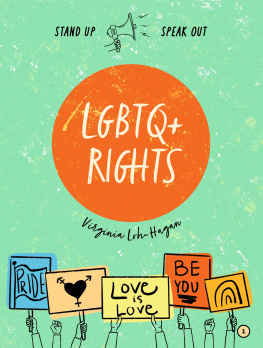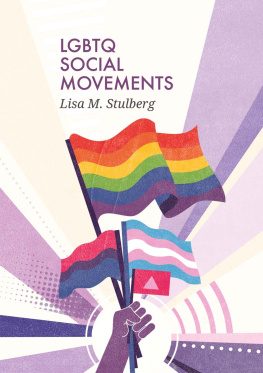
Published in 2020 by The Rosen Publishing Group, Inc.
29 East 21st Street, New York, NY 10010
Copyright 2020 by The Rosen Publishing Group, Inc.
First Edition
All rights reserved. No part of this book may be reproduced in any form without permission in writing from the publisher, except by a reviewer.
Library of Congress Cataloging-in-Publication Data
Names: Smith, Devlin, author.
Title: The fight for LGBTQ+ rights / Devlin Smith.
Description: First edition. | New York: Rosen Publishing, 2020. | Series: Activism in action: a history | Includes bibliographical references and index.
Identifiers: LCCN 2018015268| ISBN 9781508185475 (library bound) | ISBN 9781508185468 (pbk.)
Subjects: LCSH: Gay rightsJuvenile literature. | Sexual minoritiesCivil rightsJuvenile literature.
Classification: LCC HQ76.5 .S6195 2019 | DDC 323.3/264dc23
LC record available at https://lccn.loc.gov/2018015268
Manufactured in the United States of America
On the cover: Activists advocate for the rights of those in the LGBTQ+ community by participating in events, such as the 1983 C.S.L.D.C. March and Rally (top) and LGBT Pride Month parades (bottom).
CONTENTS
INTRODUCTION
I n the aftermath of World War II, as the tensions of the Cold War grew in the 1950s, the Canadian and United States governments enacted discriminatory policies against LGBTQ+ (lesbian, gay, bisexual, transgender, queer/questioning, and others) workers. Fear of blackmail and bigotry led to the creation of these policies. Potentially thousands of people lost their jobs because of their sexual orientation. The armed forces in both countries enacted policies stating that service members had to choose between being out and staying in the military. People were discharged because of these policies, ending their careers and losing many of their benefits.
Through the end of the 1960s, people could be jailed for committing homosexual acts. Police would regularly raid bars and clubs looking for LGBTQ+ people breaking decency laws. Until the 1970s, homosexuality (the term used at the time) was considered a mental disorder that could be cured. Laws prohibited same-sex couples from marrying their partners, or from adopting or fostering children. Couples that had been in relationships for decades werent entitled to the same rights as opposite-sex couples regarding healthcare, pension benefits, and more. LGBTQ+ people now serve in all levels of government in both countries. Lesbian, gay, and bisexual service members are welcome in the military in both the United States and Canada. The Canadian Armed Forces is also open to transgender service members.

The late Harvey Milk became one of the first out elected officials in the United States when he won a seat on the San Francisco Board of Supervisors in 1977.
Being LGBTQ+ is no longer a crime and no longer treated as a mental disorder. Same-sex couples enjoy marriage equality in both Canada and the United States. Same-sex couples and individuals are gaining their parental rights in both countries. These strides toward equality were made through decades of struggle by activists and allies. Change happened through marches, protests, and boycotts. Change happened through lawsuits, appeals, and Supreme Court decisions. Change happened through the work of individuals, organizations, and communities.
The people behind the fight for LGBTQ+ rights and equality were spurred to action by personal experiences, global injustices, and hope for the future. They stood up against police raids. They organized in the midst of a devastating health crisis. They spoke out for their families. They demanded their right to work, their right to serve, and their right to equal protection under the law. The fight is ongoing. It continues in workplaces where employers can discriminate against workers based on their sexual orientation or gender identity. It continues in schools where students cant access the bathroom or changing room associated with their gender identity. It continues in legislatures where discriminatory laws are still being debated.
Just as with the victories of the past, meeting these new struggles toward LGBTQ+ equality will require hard work, engagement, and organization. It will require changes in our communities, schools, and workplaces. It will require the efforts of activists and allies standing up and speaking out against injustice. You will discover some whose activism made the rights enjoyed by LGBTQ+ people possible. You will also learn about the organizations supporting the fight today and how you can support the cause.
CHAPTER ONE
THE STRUGGLE TO BE SEEN AND HEARD
O n March 7, 1967, the documentary CBS Reports: The Homosexuals aired in the United States. The television special featured interviews with gay men and mental health experts and field reports with law enforcement members. One of the gay men, the only one to show his face on camera, was identified as Warren Adkins. Actually, it was Jack Nichols, an activist and cofounder of the Washington, DC, chapter of the gay rights organization known as the Mattachine Society. In the special, Nichols shared with host Mike Wallace that while his family accepted his sexuality, others he knew had far different experiences. I had one friend who was beaten savagely by his father, and he beat him in fact with bricks. I was one of the lucky ones, my family reacted, I think, very heroically and humanely, Nichols said.
For the special, CBS commissioned a study by the Opinion Research Corporation to gauge American attitudes toward homosexuals and homosexuality (the commonly used terms of the time). The attitudes were overwhelmingly negative. As host Wallace reported, two-thirds of those surveyed viewed homosexuals with disgust, discomfort, or fear. Most surveyed believed that homosexuality was a greater threat to society than adultery, abortion, or prostitution. At that time, homosexuality was considered a mental illness and homosexual acts between consenting adults were a crime in every state but Illinois. Some faced jail time. Others, upon arrest, had their names and addresses published in their local newspaper, which often led to them losing their jobs or being estranged from their families. Employers could freely discriminate against LGBTQ+ workers, either refusing to hire or firing based on an employees sexual orientation.

Founded in 1950, the Mattachine Society was an early gay activist organization. In 1999, members Bill Reynard, Earl Gebhardt, Rolland Karcher, and Elver Barker were honored during Pride celebrations.
During this period in Canada, people lost their jobs and were imprisoned. Some even faced life imprisonment for having consensual same-sex relationships. The law was changed in 1969, but it still took decades for the military to fully integrate and for LGBTQ+ Canadians to be protected from discrimination based on their sexual orientation or gender identity.
Nearly five decades later, a 2017 Pew Research study found that 63 percent of Americans believed that homosexuality (the term used in the survey) should be accepted by society. A 2017 CROP Inc. survey found that 81 percent of LGBT (the term used in the survey) participants believed Canadian society showed a willingness to integrate LGBT communities. That same year, Canadian Prime Minister Justin Trudeau issued a formal apology to the LGBTQ+ community on behalf of the government for the discrimination faced by many Canadians in the twentieth century.
Next page
















